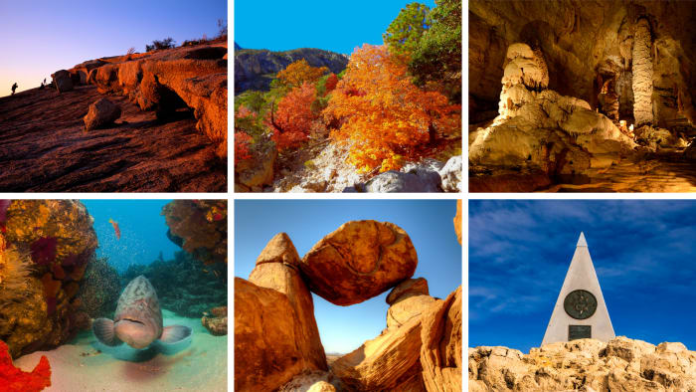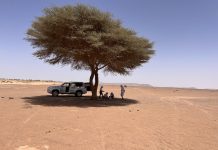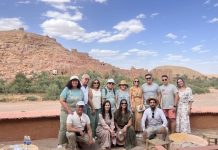Modern life comes with its conveniences, but it’s also got its fair share of stress. Chances are your phone’s constantly buzzing with breaking news, work emails, traffic alerts and the like. And even if you only occasionally peek at your phone, the stress of so many alerts and updates may have left you feeling a bit burnt out. An escape from the mind-numbing hubbub of city living could probably do you some good.
Short of chucking your phone out the window (we can dream), you’re best bet at an escape is traveling so far from civilization (and its cell service) your phone, and the world events it won’t stop chiming on and on about, cease to pester you.
Before you pull out your passport or check your frequent flyer miles, consider one of the tried-and-true Texas sites listed below. Truly, some of the state’s time-honored treasures are among the most beautiful destination in the country, nay, world.
Ad
Stating the obvious for any new Texas transplants: Be warned, these locales do not make for good weekend getaway destinations. They’re quite a ways away from the Houston area. And when we say quite a ways away, we mean some are quite literally on the other side of the state. A trek to any of these attractions will take you several blissful hours, like anywhere from four to 11, and that doesn’t even include the requisite Buc-ee’s bathroom breaks.
TRAVEL PLAYLIST: The Lone Star State in song: 100 loud and proud Texas tracks sure to satisfy the Texas-obsessed Texan in us all
The only sanctuary site in the Gulf of Mexico
Flower Garden Banks (NOAA/FGBNMS/Schmahl)
Texas scuba divers, you need not go far for good diving. Travel about 100 miles southeast of Galveston, out into the Gulf of Mexico, and you’ll find Flower Garden Banks, a national marine sanctuary (one of 15 in the country and the only sanctuary site in the Gulf of Mexico) home to some of the healthiest coral communities in the world.
Ad
The 160-square-mile segment of the ocean floor consists of vibrant, coral-covered salt domes that rise near the ocean’s surface. In total, there are 17 different reefs and banks, which support hundreds of species of marine life, including fish, rays, sharks, sponges, sea turtles, oysters and crabs. It’s an incredible dive site with crystal blue waters that rival those at the most sought-out dive locations in the world.
For more information, visit flowergarden.noaa.gov.
The Great Lake of Texas: An oasis in the Palo Pinto Hills
TEXAS, USA – JUNE 2: (EDITORIAL USE ONLY) In this handout image provided by Red Bull, David Colturi of the USA dives from the 27 metre platform during the final competition day of the first stop at the Red Bull Cliff Diving World Series on June 2, 2018 at Possum Kingdom Lake, Texas, USA. (Photo by Dean Treml/Red Bull via Getty Images) (2018 Handout)
Forget everything you think you’ve learned about Possum Kingdom from listening to the Toadies creepy 1994 hit song.
Nestled in the foothills of the Palo Pinto Mountains on the upper reaches of the Brazos River, the 17,000-acre Possum Kingdom Lake lies some 90 miles west of Fort Worth, and boasts soaring bluffs, clear blue water and around 310 miles of shoreline – nearly as much as the entire Texas Coast.
Ad
Dubbed The Great Lake of Texas, the North Texas reservoir draws Metroplexers and other Texans to its scenic shores for watersports (boating, skiing, swimming, fishing, and scuba-diving) and more (hiking, cliff diving, picnicking and general R&R).
For more information about Possum Kingdom Lake, visit tpwd.texas.gov or call (940) 549-1803.
An ancient dome in the Texas Hill Country
(Original Caption) Fredericksburg, Texas: The Enchanted Rock State Park. (Photo by David Butow/Corbis via Getty Images) (Getty)
Located 18 miles north of Fredericksburg, an ancient, 425-foot dome beckons tens of thousands of visitors to the Enchanted Rock State Natural Area each year.
The park opened for public tours in 1987 and is both a National Natural Landmark and in the National Register of Historic Places as an Archeological District. The park offers 11 miles of hiking trails. The Summit Trail, a .6-mile path which leads straight to the top of the park’s namesake dome, is the most traversed. While dwarfed in comparison to Enchanted Rock, smaller domes on site, most notably Little Dome and Turkey Peak, also offer stunning views.
Ad
Enchanted Rock State Natural Area is located at 16710 Ranch Rd 965, Fredericksburg, TX 78624. For more information, visit tpwd.texas.gov or call (830) 685-3636.
The world’s largest spring-fed swimming pool
Balmorhea State Park Pool
Built by the The Civilian Conservation Corps back in the 1930s, the swimming pool at Balmorhea State Park is a much-beloved West Texas attraction. The treasured Texas swimming hole, the largest spring-fed pool in the world, is up to 25-feet deep, covers 1.3 acres, and holds 3.5 million gallons of water. It’s also home to numerous species of aquatic animals, including two small, endangered desert fishes — the Pecos gambusia and the Comanche Springs pupfish, according to the Texas Parks and Wildlife Department.
The pool and day use areas are open from 8 a.m. to 7:30 p.m. or sunset, whichever comes first. Day passes are available for purchase on the Texas State Parks Online Reservations Center, but are limited. Day passes can be purchased up to 30 days in advance. TPWD urges visitors to purchase passes in advance online before driving to the park. Upon entry, visitors must present their reservation receipts at the park headquarters. Guests with reservations will then receive wristbands which they will be asked to wear when in the pool and day-use areas.
Ad
Balmorhea State Park is located at 9207 TX-17 in Toyahvale, about 32 miles north of Fort Davis in West Texas. For more information visit the park page on the TPWD website or call (432) 375-2370.
Fancy a swim but not so interested in a nine-hour drive? Consider a trip to one of these less-remote Texas swimming holes.
The second-largest canyon in the country
Palo Duro (Canva)
The nation’s second-largest canyon, Palo Duro remains almost completely hidden until you reach its rim, where the high plains of the Texas Panhandle drop away, revealing dramatic caprock formations.
Runner-up to the Grand Canyon in terms of size, Palo Duro is 120 miles long, between six and 20 miles wide and more than 820 to 1,000 feet deep . For comparison, the Grand Canyon is 277 miles long, up to 18 miles wide and over a mile deep.
Ad
Palo Duro (Spanish for “hard wood,” after the hardwood shrubs and trees found throughout the canyon) features dramatic geological features, including multicolored red, orange, lavender and white layers of rock and steep mesa walls.
The 1,500-acre state park provides public access for hiking, biking, bird watching, horseback riding and camping.
Each summer, the park hosts the outdoor musical “TEXAS,” a production about the Panhandle’s history set against the backdrop of a 600-foot cliff. Expect singing, dancing, fireworks and a lot of Texas humor. Oh, and a barbecue dinner is served before the show.
Palo Duro State Park is located at 11450 Park Rd. 5 in Canyon, Texas. For more information, visit tpwd.texas.gov or call (806) 488-2227.
An isolated West Texas retreat nestled among the mountains in the highest town in Texas
Indian Lodge (Canva)
The highest town in the Lone Star State (it’s situated about 5,050 feet above sea level), Fort Davis is a sparsely populated West Texas town set high in the breathtaking Davis Mountains. The scenic destination is near several must-visit West Texas attractions including a stunning state park, a historic military post, a world-class astronomical observatory and the world’s largest spring-fed swimming pool (mentioned in depth above). Oh, and as if you needed yet another reason to visit, Fort Davis reps the coolest average summer temperatures in the state.
Ad
Whilst in Fort Davis, take refuge at Historic Indian Lodge, an isolated oasis set in the Davis Mountains State Park where guests can set down their screens (unsurprisingly, cell service is less than stellar out in the middle of nowhere), stretch their legs, breathe in the fresh air and rejuvenate in the natural world.
Built in the thirties by the Civilian Conservation Corps to attract early automobile tourists, the mountain lodge resembles a multilevel pueblo village and recalls the indigenous architecture of the Southwest — think thick adobe walls, cane and log ceilings, hand-carved cedar furniture (built by the CCC in the shop at Bastrop State Park), river cane latilla ceilings and a plaza-like exterior courtyard. Additional rooms and a sparkling turquoise pool were in the late-sixties.
As if it’s stunning architecture weren’t alluring enough in and of itself, the scenic villa is perched atop a canyon, offering stunning, panoramic views of the Davis Mountains.
Ad
Indian Lodge is located at 16453 Park Rd. 3 inside the Davis Mountains State Park at Fort Davis, TX 79734. For more information, visit tpwd.texas.gov/state-parks/indian-lodge or call (432) 426-3254.
The top of Texas
Guadalupe Peak (Canva)
One of just two national parks in Texas (the other is Big Bend) Guadalupe Mountains National Park is located 110 miles east of El Paso. Known as the “top of Texas,” it boasts the four tallest peaks in the state. The mountain range is part of a mostly-buried aquatic reef complex which formed nearly 300 million years ago during the Permian period, when a vast tropical sea covered much of the region.
One of the nation’s least-visited national parks, its accommodations are quite sparse (like so sparse Big Bend’s accommodations are luxurious in comparison). There are no restaurants, stores (other than the park’s gift shop) or gas stations nearby. The nearest hotel is in Carlsbad, New Mexico. So what does Guadalupe Mountains National Park have? Texas’ tallest peak, its most iconic natural landmark (El Capitan) and some of the best fall colors, in addition to stunning vista views and more than 80 miles of trails.
Ad
For more information, visit nps.gov.
The largest commercial cave in the state
Natural Bridge Caverns (Canva)
Located west of New Braunfels, deep in the heart of the Texas Hill Country, Natural Bridge Caverns is the largest commercial cave in the state and a registered United States National Natural Landmark.
The cavern was discovered in March 1960 and opened for public tours in 1964. It’s chambers are colossal, some ceilings as high as 100 feet. The room known as the “Castle of the White Giants” contains the largest formations in the cavern, including a flowstone formation called the “Bomb Burst” and the cavern’s tallest column dubbed “The Watchtower.” “The Hall of the Mountain King,” the largest room, is over 100 feet wide and 350 feet in length.
Several different tours are offered. Get up early enough and you can take the popular Lantern Tour, the first tour of the day. On this tour, visitors traverse the cave’s passages illuminated only by the light of handheld lanterns, just like the original cave’s discoverers did decades ago. Other tours include the Discovery Tour, Hidden Passages Tour and the Adventure Tour.
Ad
The cavern’s perpetual 70-degree temperature is a delight. Its near-constant 99 percent humidity, however, is a smidge less-than. Pro tip: Bring shoes with decent traction. The floors can be a bit slippery.
Natural Bridge Caverns is located as 26495 Natural Bridge Caverns Road in San Antonio, Texas. For more information, visit naturalbridgecaverns.com.
A Texas-sized sandbox
Monahans Sandhills State Park (Texas Parks and Wildlife Department)
The 3,840-acre Monahans Sandhills State Park is merely a small portion of a massive field of dunes that extends about two hundred miles from Monohans to New Mexico. The ever-evolving landscape is a magnet for sand surfers who come to ride its steep slopes.
Rent a sandisk at park headquarters or traipse through the 800-acre equestrian estate and enjoy the spectacular views. Be warned: There are no marked trails, so make sure you remember how to get back to your car.
Monahans Sandhills State Park is located in Monahans, Texas. For more information, click here.
Ad
Big Bend National Park
Big Bend National Park (Canva)
One of the least-visited of the federal park system, Big Bend National Park is located along the namesake bend of the Rio Grande along the U.S.-Mexico border.
A place the National Park Service calls “one of the last remaining wild corners of the United States,” the 801,832-acre wonderland of gorges, mountain peaks, canyons and mesas is larger than the state of Rhode Island.
From open desert to the grassy river banks of the Rio Grande to the pinyon-oak-juniper forested Chisos Mountains, the vast expanse is a paradise for hikers (there are more than 150 miles of trails), birders (around 450 species live in the park for some portion of the year), geologists, stargazers (Big Bend has the darkest night skies of any national park in the lower 48 states) and anyone searching for a reprieve from the hustle and bustle of modern life (cell service is quite limited and the nearest town, Alpine, Texas, could hardly be described as a metropolis).
Ad
Big Bend National Park is located in Brewster County, Texas. For more information, visit nps.gov.
More:
What’s your Texas happy place? Share your Texas travel pictures with us at Click2Pins.
Copyright 2022 by KPRC Click2Houston – All rights reserved.










